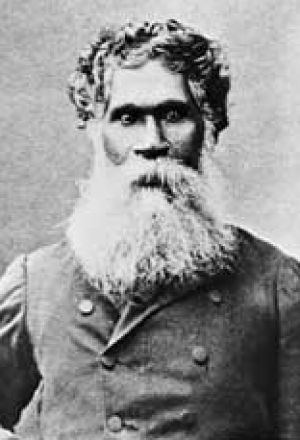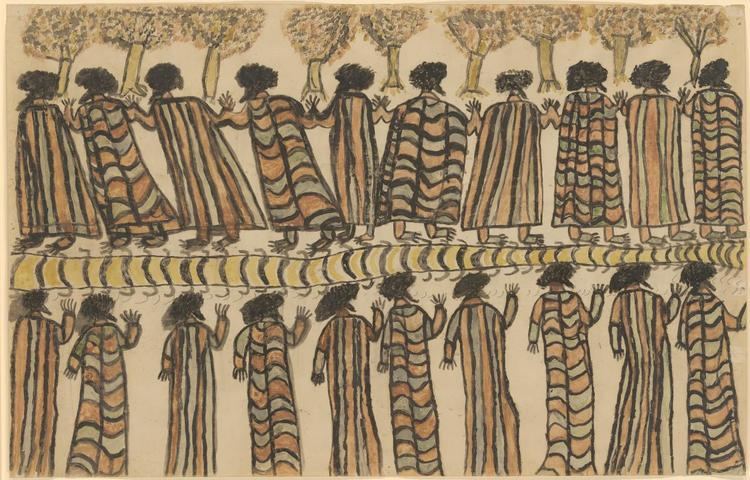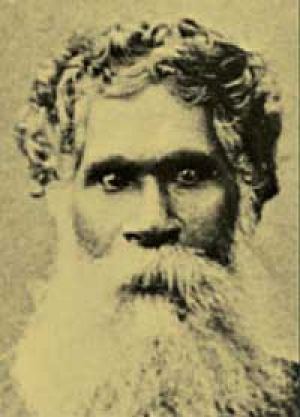Name William Barak | ||
 | ||
Artwork Figures in possum skin cloaks | ||
William barak building in melbourne cbd
William Barak (or Beruk) (c. 1824 – 15 August 1903), was the last traditional ngurungaeta (elder) of the Wurundjeri-willam clan, first inhabitants of present-day Melbourne, Australia. He became an influential spokesman for Aboriginal social justice and an important informant on Wurundjeri cultural lore.
Contents

Kulin alliance william barak peace
Biography

Barak was born in the early 1820s at Brushy Creek near present-day Croydon, in the country of the Wurundjeri people. His mother, Tooterrie, came from the Nourailum bulluk at Murchison, Victoria. His father, Bebejern, was an important member of the Wurundjeri clan. Barak was said to have been present as a boy when John Batman met with the tribal elders to 'purchase' the Melbourne area in 1835. Before he died he described witnessing the signing of the treaty in a ceremony he called a tanderem.
Ninggalobin, Poleorong and Billibellary were the leading song makers and principal Wurundjeri leaders in the Melbourne region. European colonisation had caused disruptions to initiation ceremonies. In response these three men gathered at South Yarra in the late 1830s and inducted the young William Barak into Aboriginal lore. This entailed formally presenting Barak with the symbols of manhood: strips of possum skin tied around his biceps; the gombert (reed necklace) around his neck; given his ilbi-jerri, a sharp and narrow bone or nose-peg; and his branjep, the apron worn by men to cover their genitals. At the end of the ceremony Barak presented his uncle, Billibellary, a possumskin cloak.

Barak attended the government’s Yarra Mission School from 1837 to 1839.

When he joined the Native Mounted Police in 1844, he was given the name of William Barak. He was Police Trooper No.19.

In early 1863, Barak moved to Coranderrk Station, near Healesville, Victoria with about thirty others.

Upon the death of Simon Wonga in 1875, Barak became the Ngurungaeta of the clan. He worked tirelessly for his people and was a successful negotiator on their behalf. He was a highly respected man and leader, with standing amongst the Indigenous people and the European settlers.
Barak died at Coranderrk in 1903 and is buried at the Coranderrk cemetery. He was about 85 years old.
Legacy
Barak is now best remembered for his artworks, which show both traditional Indigenous life and encounters with Europeans. Most of Barak's drawings were completed at Coranderrk during the 1880s and 1890s. They are now highly prized and exhibited in leading public galleries in Australia. His work is on permanent display in the National Gallery of Victoria Ian Potter Centre at Federation Square, Melbourne. Ceremony (1895) is housed at the Ballarat Fine Art Gallery.
In 2005 a 525-metre footbridge called the 'William Barak bridge' was constructed stretching from Birrarung Marr to the MCG, improving the link between some of Melbourne's biggest sports and entertainment venues and the heart of the CBD. In 2006 a permanent sound installation called "Proximities" was installed on the bridge. It was designed by David Chesworth and Sonia Leber. Its central section features a welcome song sung in Woiwurrung by Wurundjeri Elder, and Barak's descendant, Joy Murphy Wandin.
In 2015 a 279-foot-tall (85-metre-tall) image of William Barak was used to form the facade of a luxury apartment building called Swanston Square in Melbourne, Australia. The portrait is formed by the white balconies against a black wall.
